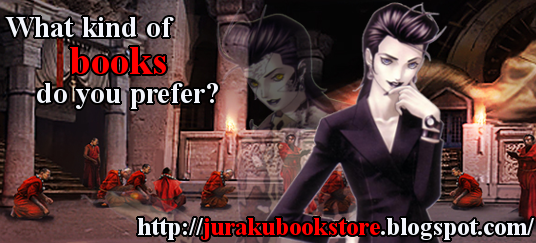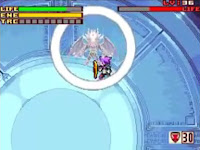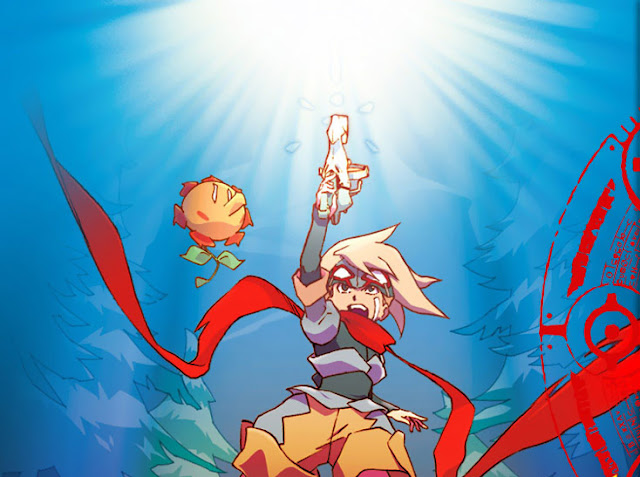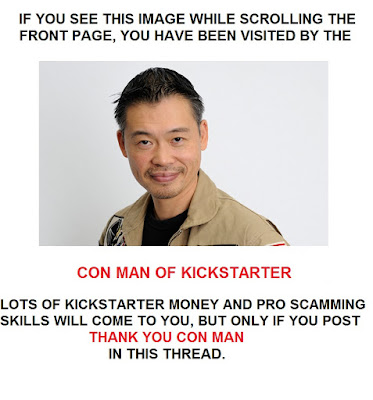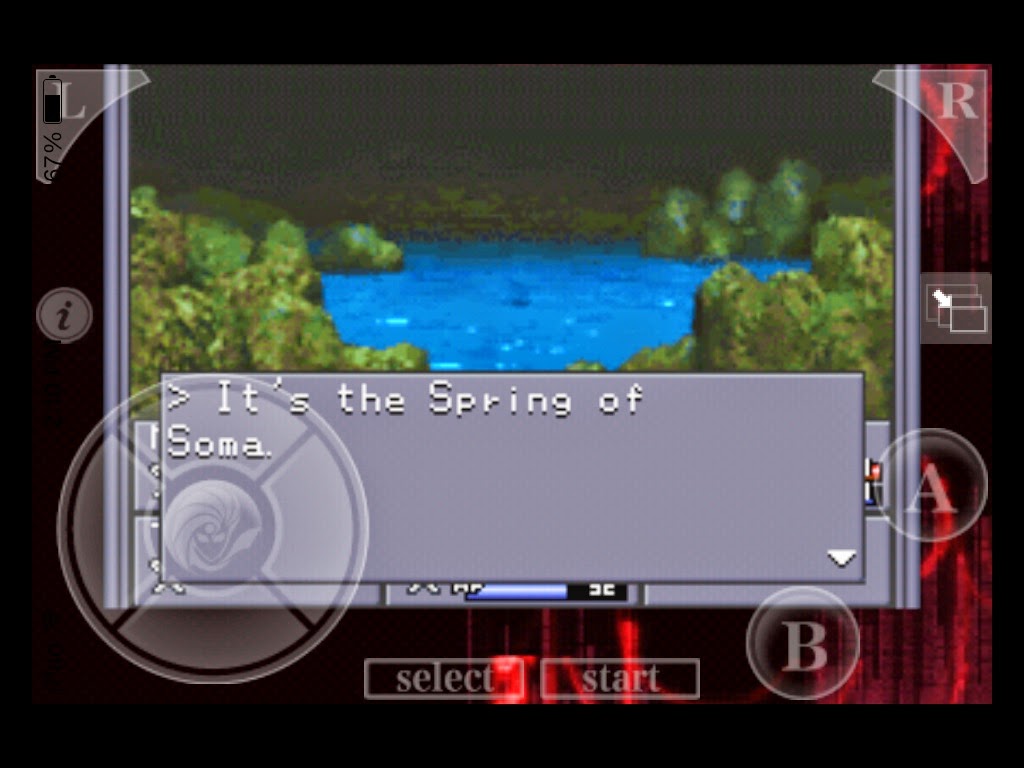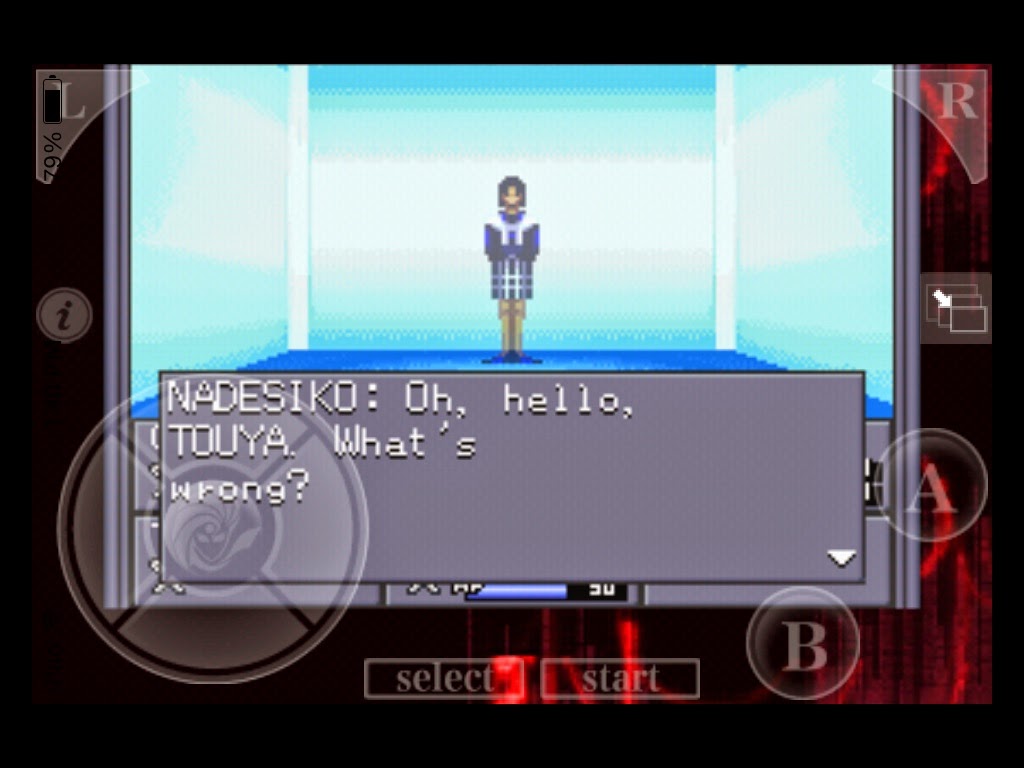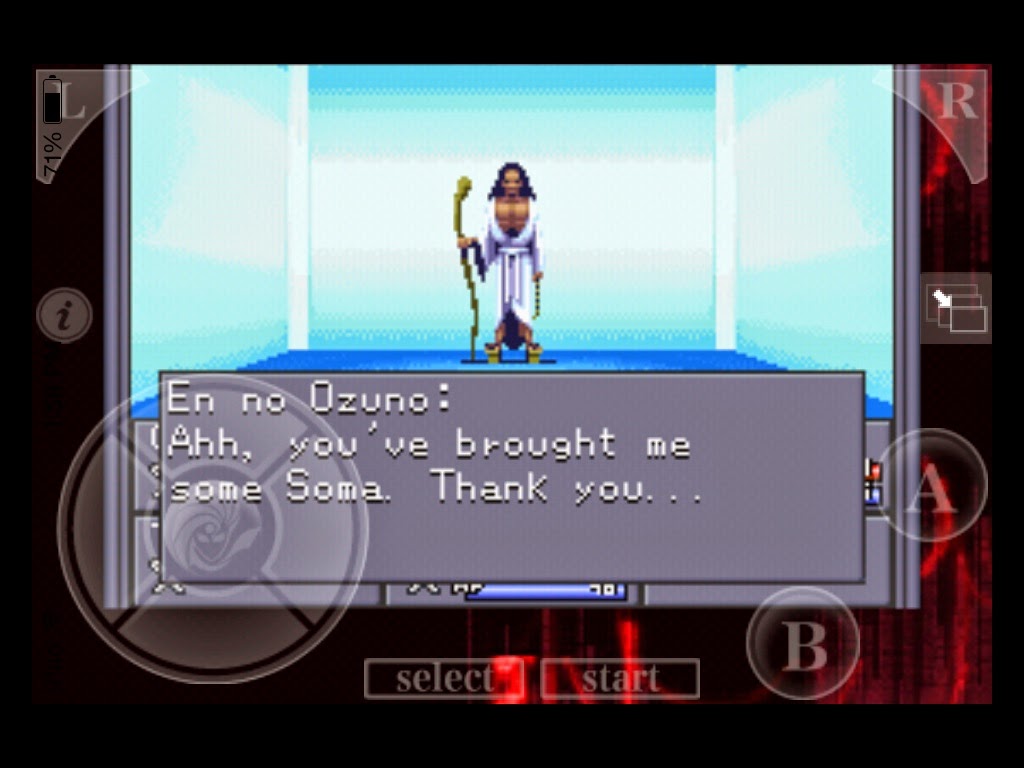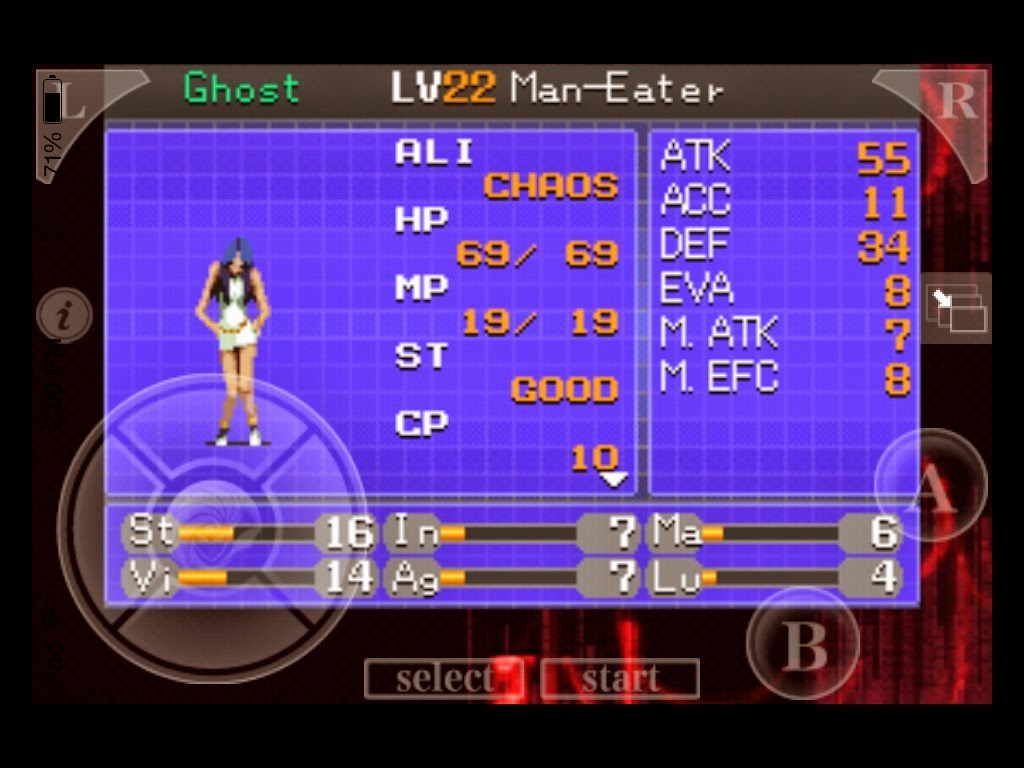In the later entries in the series, the sun also determines how long those perishables last, and in each game it plays a pivotal role in ultimately purifying a defeated Immortal to prevent it from regenerating. Each Boktai game requires the player's utmost attention and use of the sun to their advantage. Certain enemies can only be seen when there is no sunlight, requiring the player to strategically cover the solar sensor to prevent it from receiving the sun's rays, but those same enemies can also be destroyed by direct light, and by luring them into a skylight and then uncovering the solar sensor they can be instantly destroyed. This type of fourth wall-breaching gameplay is what makes Boktai so enjoyable, but it also made it a very hard game to sell to the general public.
 |
| Original image from Junker HQ |
 |
| Original image from Junker HQ |
Boktai 2's awful sales—literally one-third that of The Sun is in Your Hand's—were likely a primary motivator, but Boktai 3's international launch also had the death of the Game Boy Advance platform weighing on it. Translations of Boktai games were clearly being done simultaneous to the development of the Japanese games at the time, as they were launching two to three months after the Japanese games. Simultaneous development and translation was standard practice in the industry at the time, and had been since around 1999. Even at that pace though, Konami would be looking at launching the English Boktai 3 in September or October 2005. The Nintendo DS was already entrenched as Nintendo's new primary handheld. Boktai 3 thus also became victim to the same fate as Mother 3. It was simply too late in the system's life to be gambling on another sequel to a series that only had average to low sales, and with Boktai DS as the next logical step for Hideo Kojima's pet project, it would be better to save the company's resources for projects that needed it more and could turn a real profit.
Media Create data from August 2005 shows that in its first week Shin Bokura no Taiyou: Sabata no Gyaakushu sold 36,339 units, and by the end of the month had cumulatively sold 67,000 units since launch. By December 25th, Shinbok had sold a cumulative 85,266 units. That number put Shinbok as the 154th bestselling game of 2005 on Famitsu's top 500 chart, outselling Metal Gear Solid 3, Mega Man Zero 4, Donkey Konga, METAL GEAR AC!D, its sequel AC!D 2, and Mega Man Battle Network 5: Double Team DS. These numbers paint Zoktai as ironically the strongest-selling game in the franchise overall, despite its poor western reception, and Shinbok as the worst. And though Shinbok may have only sold 80% of what its predecessor did, as stated previously this was at the end of the Game Boy Advance's life. Konami likely anticipated that Shinbok would not do quite as well as Zoktai, leading to a smaller print run to accommodate. So while not the wild success in Japan that has sometimes been painted by the western Boktai fandom, Shinbok was definitely a financial victory for Konami, and a fairly popular game that was doing well on an end-of-life system. These factors were probably what led Konami to continue production of the series on the DS. Before addressing the sales figures of Lunar Knights though, I want to get into some of the driving forces behind the Boktai franchise's success and failure in different regions of the world.
 |
| From Hideo Kojima's Twitter |
The demise of the series began to fall into place when Konami of Japan abandoned their established pattern. Bokura no Taiyou: Django & Sabata launched on November 22nd, 2006. It was the first game to break Boktai's traditional pattern, missing the summer vacation window entirely and going out in fall rather than summer, ostensibly due to the lack of a solar sensor. Yet Boktai DS deliberately retained solar sensor functionality through the Nintendo DS' SLOT-2, which could be used with original Boktai and Zoktai cartridges. Boktai is a summer series, and if the July deadline for 2006 had been met, those familiar with the franchise would have already known to look for the DS game when it hit store shelves with the same timing as every previous entry. Unlike in the west, Boktai DS was marketed as a seamless transition onto new hardware, but to make that transition truly seamless it would have to retain the familiar elements of past entries, launch date included. According to Famitsu, the game opened at 15,053 units sold in its launch week. (A count for November published by Media Create in 2008 counted 25,866 units sold.) Famitsu's top 500 for 2006 placed Django & Sabata at 266th, selling just 45,257 units between November 22nd and January 1st. Django & Sabata was outsold at launch by both Ultimate Hits reprints of Kingdom Hearts and Final Mix. In 2010 Media Create data put the game at 280th, having sold a cumulative 73,377 units between its launch and December 30th, 2007. These were the worst sales of any Japanese Boktai game. The reasons for a lack of enthusiasm among Japanese players can only be guessed at, but it is worth nothing that Lunar Knights is to Boktai what Majora's Mask is to The Legend of Zelda. Completely unforeseen shifts in gameplay, tone, and setting, alienated Boktai's mid-sized Japanese fanbase from what would have otherwise been an easy game to love.
Lunar Knights launched in North America on February 6th, 2007. NPD put the game at 22,109 unit sales for that month, outsold by Diddy Kong Racing, Brain Age, three different versions of Nintendogs, Cooking Mama, as well as both Horsez and Catz. VGChartz's data, which lines up with NPD's and is likely derived from theirs, puts the game at a cumulative 95,827 units sold within its first year, and a cumulative 154,010 units by 2013. This technically makes Lunar Knights the best-selling Boktai game for North America in the long term, but the immediate sales between 2007 and 2008 are what matter for corporate purposes. Lunar Knights just barely outsold The Sun is in Your Hand within its first two years in North America, sales developed slowly, and the rebranding of the game worked as a double-edged sword for consumers, who had no existing IP to associate with.
The artwork for the international editions of the game was created by two western comic artists, drawn by Mexican artist Hector Sevilla and colored by German artist Simon Bork. The high quality of their work cannot be disputed, but these illustrations were commissioned as part of a failed attempt to rewrite the Boktai series as the type of game that would sell to Ebony Dark'ness Dementia Raven Way. While in the first place the public was only partially convinced that Lunar Knights was a new intellectual property, as many news outlets like IGN and 1Up were blatantly referring it as the next entry in Boktai, those that were convinced weren't persuaded by Hector Sevilla's illustrations. Lunar Knights was not an attractive or cool game to be playing at the time. The promotional artwork put up in Nintendo Power and Play magazine reeked of teenage edge and faux-steampunk aesthetic, giving it the appearance of a bargain bin upstart desperately trying to be the next big thing, with all the appeal of the similarly ill-fated Epic Mickey of a few years later.
What Konami USA was out of touch with was that anime really was the cool thing to be in 2007; the world was still in love with Death Note and .hack//, making this the perfect time for Ikuya Nakamura's art to shine. The choice to use Sevilla in the west alienated younger audiences, who historically have been a primary source of income for the gaming industry. At a time when it was beneficial to appeal to as diverse a group of consumers as possible, Lunar Knights' marketing team were making less than optimal decisions for their game's public image. Americans weren't really sure what a lunar knight was, but they knew it didn't put the sun in their hand.
Granted, Lunar Knights was going out onto the shelves at a time when that very industry was experiencing a shift in who the primary consumer was. The gamer community was being dragged kicking and screaming into a world where their values were not condoned, and game developers were no longer trying to appeal to them. This is the era in which Wii Fit, Brain Age, Halo, and LittleBigPlanet were the major titles the public was seeing on the front page of electronics magazines. It was the wrong time to be pushing an action RPG at all, and ironically the casual era may have been just the right timing to give "Solar Powered Fun" its second chance. Certainly playing in the sun would have greater appeal to the general population, which wasn't wrapped up in a basement-dwelling rhetoric of "The light! It burns!"
 |
| Official Lunar Knights artwork. |
What struck me about Lunar Knights was how decidedly un-Boktai the game was. Rather than the adventurous art of Ikuya Nakamura, the cover and manual illustrations looked like they were pulled off of a DeviantArt fanpage. The revamped artwork, the cutting of "Solar Powered Fun!/Solar Powered Action!" for promises of a "gothic world," and the (thankfully dropped) prerelease title Lunar Knights: Vampire Hunters, all seemed to bleed as much edge as Shadow the Hedgehog. Yet turn the game on, and the interior is the same brightly-colored sun-worshiping world Boktai's always been. What happened?
 |
| Illust. Hector Sevilla & Simon Bork |
(It's true that Otenko-sama was originally a play on words (お天気 Otenki; "weather" and お天道様 Otento-sama; "sun" as well as 子 ko "offspring/child") but Otenko-sama is not nearly as bad in Japanese as Toasty is in English.)
The fact of the matter is that if you take Taiyou "Sun" out of Bokura no Taiyou, what you have left is Bokura no "Our." The immature masculine group possessive. (Also a really grimdark anime.) Boktai without tai is just Bok; the monster mascot of the franchise, a disheveled zombie that searches for its prey blindly with its head on backwards. A perfect description of what Lunar Knights' promotion effort resulted in. From Ryan Payton, a senior member of LK's localization team also responsible for the art direction:
With Lunar Knights we're trying to create a new franchise really because, rather than calling it Boktai 4, we changed so much of the game, and it's a new story so we're totally forgetting everything that happened in the Boktai series. The character have new names, they've got new pasts, it's a completely different world and it's no longer a goth world. It's a goth/sci-fi mix. So we're doing so many different things where it just doesn't seem appropriate to call it Boktai. There's too many changes for us to call it Boktai in North America and Europe. In Japan however we are calling it Boktai DS. Boktai is rebuilt, reborn and with the Nintendo DS we're starting from scratch.Long before Payton was a creative director on Halo 4 or the founder of Camouflaj, he worked on the localization and promotion of Lunar Knights. It's somewhat surreal to look back and see him not as Ryan Payton, but as "a member of Kojima Productions about the new DS Boktai title." His 2006 interview is the only overt source stating that Lunar Knights was a dark rebranding of Boktai, laid out just so:
It's a different feel and a lot more mature. The world's a lot darker. The world's been taken over by vampires, who enslave humans, by sucking their blood, to keep themselves alive. It's pretty desolate, the humans are living in small pockets all over the planet and are just waiting to get kidnapped and enslaved.The myth of Lunar Knights as a revamped breakaway from Boktai was entirely fabricated by Konami USA. I don't know for certain that Payton was absolutely responsible for everything that was done in the course of marketing Lunar Knights, but he certainly seemed eager to claim responsibility for it at launch. His name does not occur anywhere in the credits of Boktai: The Sun is in Your Hand, Boktai 2: Solar Boy Django, or Boktai 3: Sabata's Counterattack. By all accounts Lunar Knights was his first experience with the series. The resulting game, when put on the store shelves, looked goofy and utterly unappealing; I remember my dad picking up the box in EBGames in 2006 and asking me "You sure you want a game like this?"
I don't mean to just harass the localization and marketing departments from my soapbox. I also want to celebrate the game, because having just finished another playthrough and looking back on it, Lunar Knights has one of the most refined gameplay system in the entire Boktai series. For all the twists it applies to Boktai's world, the core gameplay is firmly a successor to Boktai 3: Sabata's Counterattack that takes the day/night cycle, massive inventory options, weather-based item crafting, and climate-sensitive armors, and makes them all portable while removing the hassle of an obligatory solar sensor. As innovative and enjoyable as the solar sensor was—I remember the days and evenings spent playing Boktai around multiple perches on my family's mid-renovation house far better than I do any part of Mega Man X: Command Mission in that same home—it really does need to be an optional element, both to avoid placing players at a disadvantage to being able to actually play, and for it to be appreciated at all. You don't realize what the sensor brings to the table until you've played both with and without it. I can relate a specific part of my neighborhood to each boss battle in Boktai. The same goes for Boktai 2, which I initially played over the course of a trip to Salem, Massachusetts. With Lunar Knights, I didn't get a sense of spacial attachment to the game until I used a Boktai cartridge in SLOT-2 to enable the solar sensor. (I specifically remember purifying the Poe twins outside of an especially uninteresting youth group session. I hope I never set foot in Crossroads again. )
Bokura no Taiyou: Django & Sabata makes a series of trades in taking the characteristics of Django and Sabata and redistributing them among Django (DS) and Sabata (DS), the characters that would be renamed Aaron and Lucian in Lunar Knights. By reclassifying Sabata from Dark to Lunar, his game mechanics of taking damage under sunlight, charging energy under darkness, and generally inverting the traditional sun-oriented gameplay are excised entirely. Instead, Sabata (DS) becomes a moon-derived copy of Django, inheriting his entire classification of Boktai 2 melee weapons (sword, spear, and hammer) but also suffering from a lack of range and weapon diversity. All of the weapons used by Sabata (DS) are essentially the same in gameplay, with each giving up progressively more advantages in order to veneer into higher and higher power digits. Many players believe his starting sword Vanargand to also be his ultimate weapon, and they're not wrong in thinking that. Vanargand is fast, has a higher base power than almost all of Django (DS)'s solar guns, an extended combo when fully leveled up, and is easy to cancel into Sabata (DS)'s shield. The other two weapons unlocked as one progresses trade speed for range and more raw power, with the third and final weapon—the dark scythe Hel—losing the ability to combo entirely in exchange for reaching practically across the screen. Hel is also unmatched in both base and potential power. Like Sabata (DS) himself, Boktai DS' dark weapons give up progressively more game mechanics in order to stack on raw unbridled strength, crippling one's own defenses beyond repair and devoting everything to destroying a singular enemy.
By contrast, Django (DS) inherits the solar aspects of Django, including each of his gun options. Rather than having a multitude of customizable gun parts, Django (DS) instead has each set of parts consolidated into one complete weapon, giving him a final total of five different guns to choose from. When this works, it's a wonder of convenience being able to quickly change from a rapid-fire dual gun set to a homing missile attack in seconds, but this really is a trade and not just a straight improvement over Boktai. The fact that grenades, once a staple of Boktai's gunplay, are relegated to being an entire class of gun with no secondary effects or utility purpose leaves veterans that remember strategizing around them crestfallen. Several of the guns in Boktai DS are outmoded long before you ever get them. The second solar gun you receive, Witch, is likely the best weapon in the entire game. Why surrender rapid fire for greater power, or power for better rapidity, when Witch exists at the optimal intersection of every property and has a unique homing ability? Django excels in the long-term compared to Sabata because of his diverse weapon lineup for dungeon exploration, but when it comes down to actually fighting he's often bootstrapped to a specific gun.
The trance mechanic is what ultimately balances the two characters out. Sabata (DS) inherits the original Django's dark trance, while Django (DS) receives his sol trance. Each of these trances is functionally identical, overriding all weapon options and assigning the Y button to a single-target homing attack and the B button to an area-of-effect spell, but where they differ is in what properties they restore. Sabata (DS)'s vampire trance drains the target of its health to restore his hit points, while Django (DS)'s sol trance deals damage but transfers that damage as energy to Django (DS).
The problem with this is that the game's level system biases Django towards having higher energy and Sabata towards lower hit points, because it costs more points per level to increase Sabata's HP and less points per level to increase Django's energy. Sol trance addresses a problem that Django doesn't have by giving him easy access to energy restoration, while dark trance covers up Sabata's weaknesses by making up for his poor HP growth with an effective free restoration skill that rewards getting into battle more often.
Trance also plays a greater role in characterization than it did in the first three Boktai games. While strictly speaking all of the primary bosses in Lunar Knights use the planet Earth's Terrennials to control an element in battle, the climax boss Dumas is the only one to use the trance mechanic to fuse with one in the same way that Sabata (DS) and Django (DS) do. Dumas' transformation builds on existing visual similarities between him and Sabata; in their base forms both characters already wear identical casket armor beneath their coats to protect themselves from the sun, but while Dumas buttons up to conceal his armor, Sabata wears his coat open and flaunts his powers. In trance Dumas and Sabata respectively take on the characteristics of their Terrenials, Perrault and Nero; Perrault's white feathered wings attach themselves to Dumas' head, while Nero's red bat wings fuse to Sabata's. Dumas becomes airborne while Sabata remains earthbound, and the vampire sheds his coat while the vampire hunter retains his. Aside from character design choices, during the actual boss battle Dumas turns the player's abilities against them, using the same moon-derived powers as Sabata through "Lunar Flare," which reflects any elemental abilities back to the player as damage, and if they attempt to use trance, Dumas will fight back harder and actively counter their killing moves. If the player tries to use Sabata's Dark Fang, Dumas will respond with his own version of the ability and suck the player's blood instead. Dumas and Sabata makes use of the same dark powers in entirely different ways, reflecting the divergent paths they follow.
Making the gameplay reflective of the characters was a very effective way to use the medium, but by making these trades Kojima Productions also made the game at times unfun to play. Sabata (DS) is boring compared to Django (DS) because of his lack of options. The player is disproportionately encouraged to use Vanargand over the optional weapons that have to be excavated. My eventual conclusion was to main Jormungandr, his spear and the middle weapon between Vanargand and Hel, because while it has restrictive speed properties like Hel it's still possible to hit an enemy twice with each thrust if your attacks are timed and spaced correctly. Ultimately Sabata (DS) is a damage-per-second character that excels at efficiently putting out numbers, and compared to the original Sabata's inverted stealth gameplay, he's uninteresting to use even when he's dominating a boss battle.
But in spite of these shortcomings, the guard mechanic was Lunar Knights' most important and most fun addition to the series. In retrospect it's difficult to see how Boktai 2 missed out on introducing something as basic as a shield in the first place. Lunar Knights rewards carefully watching enemies even as you're attacking them, in order to stop your own attacks and guard at exactly the right moment to stun them. The delay between stopping an attack and putting a shield up forces you to time your movements carefully, and think strategically about both melee and ranged combat.
Helplessness in Lunar Knights is thus a factor of skill level. Moreover, the Enchant abilities from Zoktai returns through the Terrennials. While I've encouraged readers to compare this game with Shinbok, arguably Boktai DS is more Zoktai than it is Shinbok. Each Terrennial fills a role as a messenger of their respective element and its role in the ecosystem, and can also imbue Sabata (DS) and Django (DS)'s weapons with their respective attributes of Sol, Dark, Fire, Frost, Earth, and Cloud. (The original Luna and Star elements are technically missing from Boktai DS. Luna only exists for storyline purposes and not in gameplay.) While Django in Shinbok had the ability to swap out different elemental lenses to get access to these attributes, he couldn't imbue his swords with those elements on the fly as in the preceding game. Lunar Knights bringing back the Enchant spell is what allows its equipment system to function. What's missing is that Django (DS) cannot use Nero to get the Dark element, and likewise Sabata (DS) cannot use Otenko for the Sol element. (In the Japanese edition games their use of those Terrennials was possible through the use of emblem items that were removed in the international Lunar Knights.)
 |
| Original image from Junker HQ. |
To fill the gaps left by stealth's removal, we have the weather system, which encourages more macro-level thinking than any preceding game mechanic. Lunar Knights took full advantage of its solar sensor-free system, setting the player in the position to use the Terrennials' powers to change the climate freely before entering a stage, thereby modifying the level so that different areas become accessible and optional content can be accessed. Each weather condition also comes with its own unique events; under the balmy subtropical climate (represented by the Sol Terrennial Otenko) meteor showers will occasionally occur between 11AM and 1AM, as well as between 11PM and 1PM, increasing the drop rate on items from defeated enemies to 100% and causing enemies to always drop their rarest item. Under the tropical rainforest climate (represented by the Earth Terrennial Tove) the drop rate for items in the field from breakable objects is dramatically increased, creating an opportunity for the player to choose specific climates that suit the level they're going into, to reap the best bonuses possible. Climates with adverse weather conditions affect battle in different ways, with hail dealing continuous minor damage to both the enemy and the player, but also instantly killing Fire-attribute monsters.
 |
| Left: Lunar Knights. Right: Shin Bokura no Taiyou. |
Prominently, there is no solar forging mechanic. In Solar Boy Django and Sabata's Counterattack the player could reforge off-the-line swords and spears with accessories to create new, magically-endowed weapons, using the solar sensor to detect how much sunlight was available to charge them with. The more sun the sensor detected, the more power was available while playing a mini-game of fanning the fires of a forge and then hammering the weapon into shape. This gave way to a very unique method of item crafting exclusive to the Boktai series, where a player's local climate determined the types of weapons they could produce and what special abilities they could gain, meaning that their point of origin would be reflected in multiplayer through the weapons they fought with. Lunar Knights does not have weapons that can be found in the field, and instead replaces solar forging with straight "pay money and X number of items" upgrades to weapons automatically inherited through the storyline. While that results in more unique identities for each weapon, it also results in less individuality and free exploration on the player's part.
All these details come together to create one of the most cohesively action-oriented yet also disappointing entries in the Boktai franchise. Lunar Knights is a journey to play, but it's also far more forgettable than any of the preceding three games. Several of the boss fights are lackluster and easily steamrolled if you so much as touch the game's sidequests, so that you don't really enjoy nor are challenged by those battles until you re-fight them at higher levels in the postgame content. The game may seem challenging to a first-time player, but if you get even surface mastery over using the weather system, or dip a toe into the optional content, the storyline quickly becomes a paper tiger.
The battle system is genuinely enjoyable once you're using fully upgraded weapons and equipment against high-level enemies, but the problem is that Lunar Knights makes you work for between twelve and twenty hours to get to the really fun parts of the game. The first three Boktai games always have you on the verge of death, encouraging stealth even when they veer towards action, rewarding the player for purifying the undead without ever actually being seen or heard. The fourth Boktai is a raw action game with all the pitfalls of one. It is telling that the most enjoyable and Boktai-like segments of Lunar Knights exist on a macro level, in the huge number of perishable items and different ways to enhance or combine them through manipulating the weather. In the frigid arctic climate the temperature is just low enough for Magical Drinks to freeze over into Miracle Ice Pops instead of spoiling; in the arid desert climate the precipitation falls into the right threshold for Delicious Meat to become Dried Meat instead of rotting. Ordinarily spoiled chocolate becomes Melted Chocolate with reduced recovery properties, but if two pieces of chocolate are allowed to melt on top of one another, they'll become Deluxe Chocolate with doubled properties. There are also a vast number of (redundant) treasure items to be collected in the game and sold off for funds, including a whole line of photographs featuring the core cast, and broken versions of solar guns from previous Boktai games. Bizarrely, the most action-oriented entry in the Boktai franchise shines brightest when one looks at its creative inventory.
The localization for Lunar Knights is a strange beast. One front on which the game is markedly different is how cinematic it is, with fully emotive portrait busts for every character, and periodic anime cutscenes interspersed that were never to be found in the first three games. One consequence of this is a more involved translation than past games needed. The Sun is in Your Hand was very freeform, dungeon-oriented, and sparse on narrative sequences. Solar Boy Django had more text, but no cinematic approach. In Lunar Knights there are the requisite "dang it/darn/that jerk" moments that adults will roll their eyes at, but peppered alongside these are instances of gratuitous swearing—"damn/you bastard/shit"—that one gets the impression were introduced purely to try and grab a T rating and swing over the emo crowd. (If this was the case, the localization team was unsuccessful.)
 |
| Sartana, Illust. Ikuya Nakamura |
As far as the Japanese names go, this Django and Sabata are not exactly the same as the originals from the Game Boy Advance series; yet in light of the alternate timeline that Lunar Knights exists in, parallel to Shinbok's timeline, it's clear that they are the successors to those two in as much as Link and Princess Zelda are to their own predecessors. In the timeline where the Immortal Ratatosk succeeded in awakening the Beast of Destruction Vanargand, and Dumas took over after his reign ended, these characters are Django and Sabata's second chances to renew their promise with the sun and earth. "Reincarnation" is perhaps too loaded a word to describe how Django (DS) and Sabata (DS) are connected to their GBA counterparts, especially with Sabata already being a direct reincarnation of another character. Boktai has always had a recurrent theme of light coming through no matter how deep the darkness gets, nor how long the night goes on. On a narrative level it would be entirely correct to say that Django (DS) and Sabata (DS) are to Django and Sabata as one sunrise is to the previous sunrise. It's still the sun you're seeing, but each day is new, and the sun never rises exactly the same as before.
The attempts to divorce Lunar Knights of its origins were ill-conceived. Past several key story points in Lunar Knights, it's possible to return to major dungeons and explore past the boss room, deep into a series of underground chambers that the vampires were excavating prior to their defeat. The earliest of these is Margrave Rymer's mansion, which at its terminal point contains an elevator shaft leading to a series of tunnels that open onto the ruins of "San Miguel," though the actual section explored is from a part of Istrakan featured in Boktai: The Sun is in Your Hand.
Istrakan's Firetop Mountain is reproduced pixel for pixel beneath Rymer's mansion. While over the years certain areas have been blocked off by solidified lava floes, the central cauldron around which the player primarily navigates from is unchanged. I felt a very specific nostalgia when I first stepped back into Firetop Mountain. The developers for Lunar Knights reproduced the sights and sounds of the area perfectly; it's only when the player steps onto a rock platform over the lava that they hear the churning boil of molten rock underneath, just as in the The Sun is in Your Hand, and the heavy thud of the platform crashing from one end of the level to another. The timing of it is exactly as it was on the original hardware. No one forgets those sounds.
Much like San Miguel and Istrakan to Old and New Culiacan, Boktai is a force that cannot be buried by Lunar Knights. It is constantly lurking beneath the surface of the game, ever on the verge of pouring out at every seam and overwhelming its world. Anyone familiar with Shinbok's storyline will recognize Lunar Knights as a direct sequel, not a "spiritual successor" or whatever other distancing monicker Konami USA felt comfortable with. You can't try to mold a world into something it's not, without the artist's vision biting back at you.
In November 2014 Kojima stated that there were no plans for a fourth Boktai, and his departure from Konami has seemingly closed off all hopes of a future installment. But for diehard Boktai fans, there is always one recourse;
「明日もまた陽は昇る!」
"The sun will rise tomorrow!"
—Master Otenko
